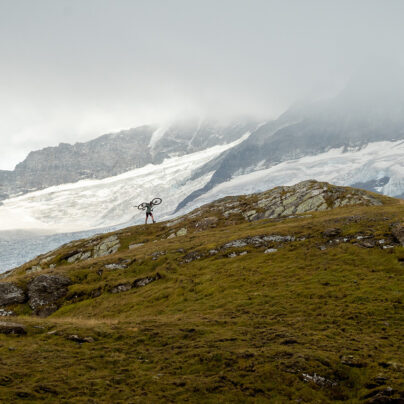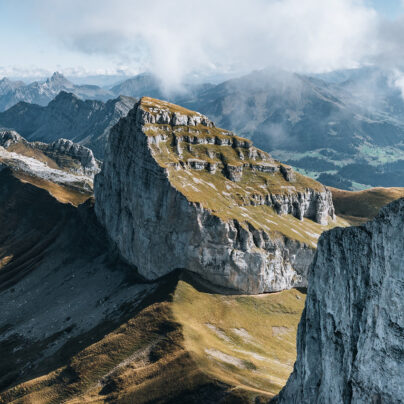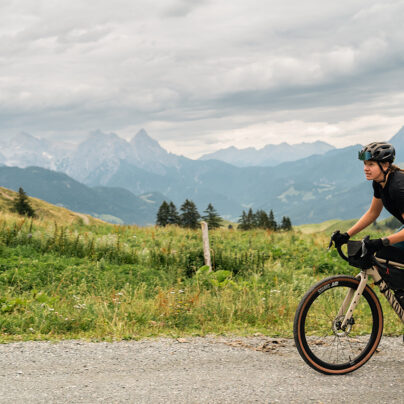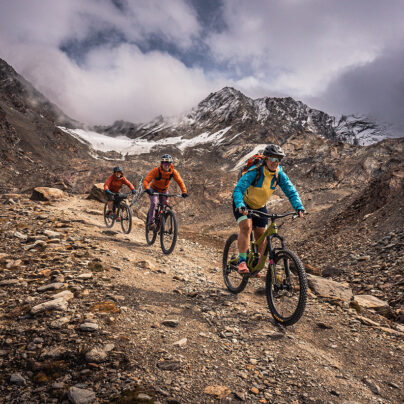A Game of Rivers
Three Months Bikepacking in Iceland
Story and Photography by Joffrey Maluski // Written by Alex Roddie
When Katia, Léo-Paul, and I came to Iceland, we knew that we would have many hundreds of rivers to cross on our three-month journey. We came out here expecting to get wet. We’d come for wilderness – and for as thorough an exploration of Iceland as time would allow, crossing its interior from north to south and east to west.
Relentless headwinds batter us for most of our first month as we make our way through the Westfjords, riding on good tracks, deserts of energy-sapping black sand, and everything in between. Riding our heavily laden bikes through deep sand is tiring enough as it is, but add the wind into the equation and the result is progress that at times feels infuriatingly slow. The force of the wind pushes us to the sides of the road (and sometimes off it). And it’s cold, too – I’m wearing multiple layers against the chill. I don’t think any of us expected the headwinds to be the main challenge.
Ahead, I see Katia, colourful in her orange jacket. A gust makes us all wobble and veer to one side, but she lets out a ‘Woooo!’ of exhilaration. This trip, so far, has been pure fun. Although tailwinds remain an elusive myth, we don’t mind too much. We came here to absorb the essence of this wild and beautiful country, and the wind is an integral part of that.
When I visit a new country, I want to do it properly, not just spend a couple of weeks there. The maximum length of visa I could obtain for Iceland was three months. So I planned a three-month bikepacking itinerary weaving a vast figure-of-eight throughout as much of the country as possible. With me came Léo-Paul, an old friend since our school days. We’ve enjoyed many adventures together, such as a crossing of the French Pyrenees three years before. Katia, his girlfriend, was eager to come along too. Although this would be her first bikepacking trip, she made up for a relative lack of experience with sheer zeal and motivation.
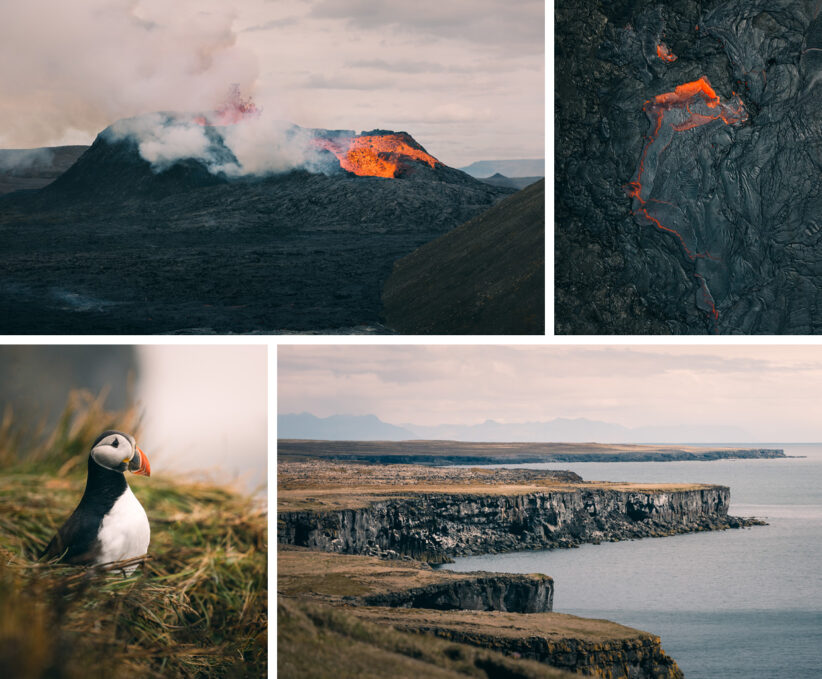

Already we have seen wondrous things: glaciers, mountains, waterfalls, and more rivers than I can count. This first month is going to prepare us well for the rest of the journey, I think, and with joy in our hearts we pedal on, eager to experience more of Iceland.
‘There’s another river coming up,’ Léo-Paul yells from behind. I look back at Katia and see that she is grinning fiercely. Almost 3,000km ago, at the start of the journey, she’d been hesitant to pedal straight through a river. But she had soon taken to the water, and now we all relish the challenge of staying on our bikes while crossing. Sometimes it works, sometimes it doesn’t. It is a game.
We’re cycling through an open landscape of barren sandy plains, threaded by a complex multitude of rivers and streams all flowing outward from the great icy hub of the Hofsjökull Glacier. The water flowing from this gleaming white plateau is cold and thick with sediment. If we can avoid dismounting and splashing through icy water that often comes up to our knees or more, then so much the better. Besides, it’s more fun this way.
Léo-Paul hits the ford and sheets of water fly up from his wheels. He slows, wobbles, but makes it through. Next: my turn. There’s a knack to this – and we have all had a lot of practice. But I’m either going too slowly or have come in at the wrong angle, because soon enough my bike topples with a splash and I’m standing there with the cold pressure of the river against my calves. ‘Yeah!’ Katia shrieks in a battle cry, and comes in right behind me, soaking me in her wake. We all laugh.
***
We’d known that the two-day 90km stage around Hofsjökull would be the most serious of the trip, but not for the sheer number of river crossings. Two of the rivers on this section are big, and everyone said that we wouldn’t be able to cross them with bikes. Detours to avoid them could be long and hard. This is serious country.
Yesterday hadn’t been too hard: three or four moderate crossings, but then we’d come to the banks of the first big river at 4pm, far too late in the day to make it across. The current roiled, angry and cold with the day’s meltwater from the ice cap only 2km upstream.


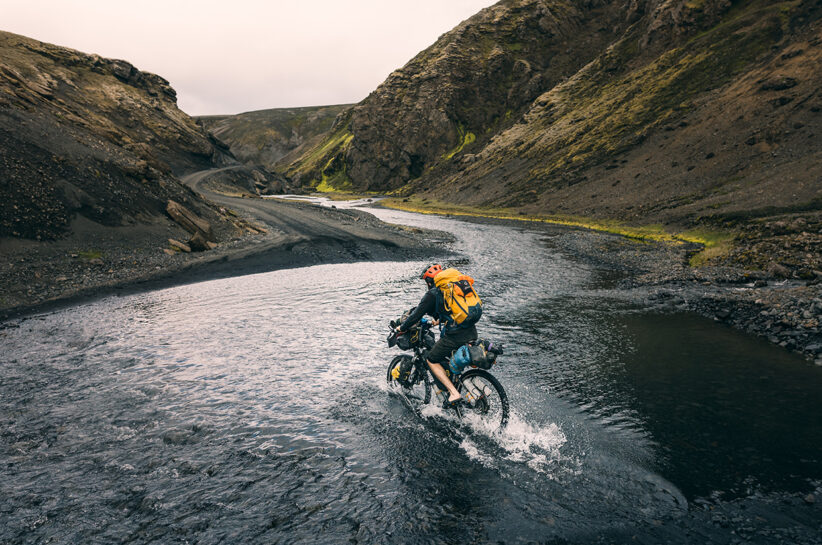
Now it is 4am and we’re having another go. The golden Arctic twilight washes over the landscape as we push our bikes into the water one by one. Now the glacier sleeps. The current is still energetic, pressing against our legs with insistent force, but no longer violent – and the level has dropped dramatically overnight. My feet, protected by neoprene slippers, burn with the cold as I try to feel my way across the riverbed. The water is grey and opaque. Sand and small pebbles shift beneath my soles. ‘I’m going to get my ass wet,’ Katia says, but we’re all quieter than usual as we negotiate with this river.
The water comes halfway up my thighs before it starts getting shallower again. The weight of my bike acts as an anchor, and I lean into it, using its reassuring ballast to keep myself true in the current. Without our bikes, these crossings would be so much harder.
***
There is one more major river to cross before reaching the F35, a road marking the end of this challenging wilderness section. After crossing countless other smaller streams that day, we come to the big crossing, and stand there on the bank looking out across the expanse. ‘It looks deep,’ Léo-Paul says; neither Katia nor I respond. This ford will need to be tested before we commit. So I leave my bike with the others, change into my neoprene slippers once again, and step out into the churn.
Immediately the cold takes my breath away. I take step after step, and the water comes higher up my legs each time. Five metres from the bank and it is up to my hip. I lean into the current. Stones shift under my feet and suddenly I feel insecure. ‘Not here!’ I call back to the others.
The rangers had been right – this is not a safe crossing, at least not right here. Now we discuss the prospect of a lengthy diversion upriver. It isn’t what we’d planned, and this could be a long day, but we’re here for the adventure.



Upstream, the river splits into a complex braided interplay of channels and sandbanks, spreading out over a wide area. It’s a maze. But the channels are far shallower here, and we pick our way from sandbar to sandbar with the bikes, often staying in the saddle as we spin through. ‘How far to the other side?’ Léo-Paul calls, and I reply that it isn’t far. We’re playing the game – and we’re winning. Although every river deserves to be treated with respect, that sense of fun, of joy, has never left us.
Long days on bikes have their ups and downs. There are moments of doubt – worries about river crossings, accumulated fatigue – and you can be irritated by steep slopes or the freezing water. But by counting on each other to keep spirits high, we make it through this difficult day. It takes us 16 hours to pedal, push, and carry the bikes. Altogether we cross almost 20 rivers for only 50km of progress, but we make it to Hveravellir.
Sometimes you fight and sometimes you fly. I can only advise you to get on your bike and don’t stop. Those first pedal strokes may be difficult, but the rest is nothing but happiness.
The new film, Bikepacking Iceland, chronicles three months and 3,000km of bikepacking into the most remote parts of the Icelandic Highlands, dominated by huge glaciers, volcanoes, sandy deserts, and with many rivers to cross.




